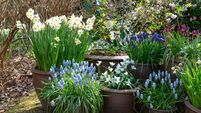Behind the walls of a secret garden

IT IS 25 years now since the late Brian Lenihan made his much criticised remarks about emigration from Ireland.
While his timing and delivery may have been questionable most people would agree with the sentiment of his words, namely that it could only be good for Ireland that young people would leave, learn skills and experience different cultures and ways of doing things in foreign countries and then return to Ireland with this extra experience and knowledge.

The operative word in the last sentence is ‘return’. What landed Mr Lenihan in such hot water was that so many emigrants historically, and at the time, never returned.
We can only hope that those that have had to leave modern day Ireland will be able to return with their expanded outlooks should they so wish.
Emigration in the 1800s was different and for those who left during the 1840s there is a particular historical resonance. They never got back, not even to visit.
It’s fitting then that in 2012, the grandson of emigrants who left Co Waterford during the 1800s found himself the proud new owner of the magnificent Woodhouse Estate in Stradbally, Co Waterford.
This rambling old estate dates back to the 1700s and indeed there may have been a home here even earlier.

Some 150,000 hardwood trees were planted on the grounds in 1794 by the Beresford family who built the current Woodhouse and they remained here until the 1980s since when the property has gone through several owners and has spent quite a time unoccupied.
The passage of time and the lack of a loving family to mind it will lead to the deterioration of any home and garden and so too with Woodhouse and I can only imagine the task that faced the current owners when they assumed the mantle of caretakers of this magical old place.
In the house, walls needed to be fixed, the roof needed work, and in short the poor old girl needed not a small bit of attention.
She has now received the necessary work and this is a house as fine as you will see anywhere.
A walk from the house down a path flanked with trees mature and newly planted brings you to the walled garden which has just undergone a magnificent transformation.
What greeted the new owners in 2012 was an unkempt mess of brambles, scrub and disintegrating walls. Nature will recolonise whatever is left unmaintained seeming to gobble up walls and paths in its greenery.

Inside theses fading walls were some derelict stables and a sloped garden with a fall of about 6 metres. What greets the visitor now is a fully restored and redesigned garden.
The walls which were giving into the strain of neglect have been meticulously restored and repaired brick by brick and stone by stone.
One look at the finished walls tells you that this was a labour of love, there is no way anyone could have created such spectacular walls and given such attention to detail unless they really felt what they were doing.
They needed to love it, the result is impressive. New limestone steps cut through the newly created terraces leading to what will be the focal point of this whole area, a giant, in proportion water feature. When I visited, it was a concrete shell but one could make out the idea of what it will be like.
They don’t hang around up here, it has only been three years since the purchase and the place has been utterly transformed from top to toe so I suspect that this water feature will be completed and open to inspection by July 26, which is the day that for three hours the public is invited to view these exquisite gardens at Woodhouse.
It was a young local man, John Darcy who first drew my attention to the important work going on here as he is organising this open garden event to benefit four extremely worthwhile charities: To Russia With Love, Irish Dogs for the Disabled, West Waterford Hospice and the local Tidy Towns group.

In my work as a gardening columnist, I often visit established gardens of repute, many large and some small to cover them for the Irish Examiner; and in my role as a horticultural consultant I also visit gardens, advising and recommending on what can be done.
It is my job to see potential and to give ideas and to help those ideas become real. I always get the feeling of the history when I am walking through old gardens, thoughts of what the garden has seen, people who have enjoyed it and visited it.
I often wonder what a great old garden must have looked like at the start and during its infancy. What’s happening in Woodhouse gives you the opportunity to see just that.
You can see a great garden being created before the cement in the newly restored walls has set, so to speak. What’s happening here is important. Important from a historical point of view, architecturally and horticulturally.
Important too from a socio-economic perspective with so many tradesmen from rural Waterford and beyond involved in this great rebirth at a time when many, like the grand-parents of the current owners did, are emigrating due to lack of opportunity and employment in their own area.
I am certain that in 200 years from now people will come to this great Irish garden and will be wondering how it looked in the beginning and what stories and ghosts does it contain. You have the chance now on July 26 to say I know how it looked, I was there.
Within the walled garden you will admire classic herbaceous plantings with the inky blue salvia carradonna taking centre stage on the day of my visit and nepeta with its paler blue flowers flouncing about the place.
Miscanthus, carex and stipas are planted to offer texture that only grasses can bring to a planting, thalictrums and phlox too are there to extend the season of colour and hydrangeas also will bring the flowering period right into early winter.
If I raved about the work of the stone-masons well let me assure you I am equally as enthusiastic about the carpenters and woodworkers who have been on site as the quality of their work in garden doors and gates and not to mention the restored stable buildings is second to none.
One such door from the walled garden which leads to the river walk has been framed with the simple white rosa kiftsgate.
This river walk which has been planted heavily with Japanese maples skirts the eastern boundary of the walled garden and flanks the River Tay and leads you to the side entrance to the newly established orchard from where you can wander back into the walled garden or up to the higher path from where you can talk to the native deer which will inspect you with disinterest from a distance.
This will bring you to what will surely become the engine room of the entire garden, an impeccably reproduced Victorian glasshouse and potting area. The glasshouse comes complete with cold frames and pineapple pits. I wonder will we see Waterford pineapples for sale at the local farmers’ market before too long.
On first entering the gardens I had much to learn about the place, its history, what was happening now, more information about the open day and some of the nitty gritty details such as the size and scale of the place.
However, the one question that I really wanted to ask was what kind of person undertakes a project such as this in modern day Ireland and was it simply another project to a wealthy emigrants descendant, something that he was throwing a blank cheque at, for a project like this will swallow up budgets, a trophy project perhaps or was it something that he was passionate about, was it something that he was ‘feeling’.
I wanted to meet this man to ask him these questions but by the time I had finished my walk around with John Darcy I had no need, all my questions were answered.
From the smallest details such as the ropeswing hanging from a beech tree with the names of his children beneath, a particularly stunning oak tree which is illuminated at night and the intricate attention to detail which has been given to ensuring that this restoration project has been sympathetic to the surrounding countryside and the estate itself, I could be left in no doubt that this is a garden being developed as a family home — a garden to love and in which to be loved.
Yes it’s on a grander scale than most but for a garden to work it needs to possess some soul, it needs to have feeling and atmosphere, much of which comes from age and what has gone before but for it to be a truly living entity it must possess part of the current caretakers, this garden does.
It’s magnificent, awe inspiring, breathtaking and every other adjective I could think of, but it’s also a home to the grandson of young man who lived, maybe just 100 metres down the road before he went to create a new life nearly 200 years ago.
I can only imagine the feeling of life coming full circle Jim and Sally must feel, they have most likely stopped some modern day emigration and what they have ensured through their work is that this stunning patch of Ireland will remain in the condition that it warrants for at least the next 200 years.
It speaks reams about them as people that they did not want me to write about them and their story lest it would deflect attention from the important open garden event which is happening on July 26.
Do not miss your opportunity to see Wooodhouse which will be open from 2-5pm, refreshments will be available, try your hand at tennis if you wish, croquet if the lawn is up and running or simply stroll through some of the stalls from local producers.
The €10 admission fee will be divided among the charities listed.









